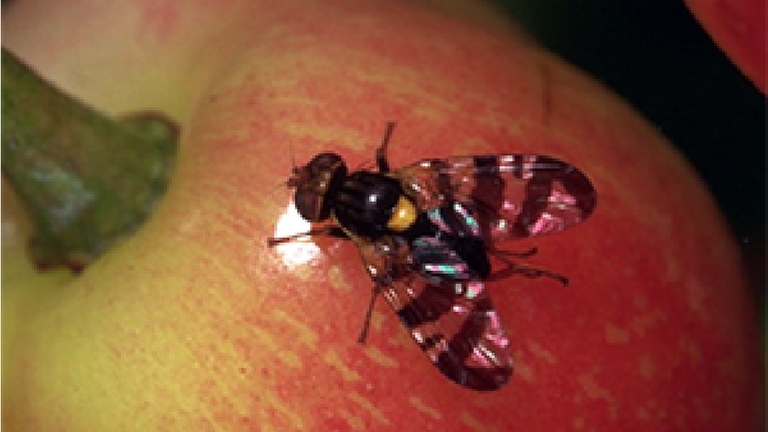European Cherry Fruit Fly

The European cherry fruit fly (Rhagoletis cerasi L.) is a serious pest of cherries. The fly damages ripening fruit, causing it to rot and fall off the tree.
European cherry fruit fly is found throughout Europe and in parts of West and Central Asia. It can spread to new areas through the transport of infested fresh cherries, soil, or fruit from host plants. Canada confirmed the fly at several sites in Ontario in 2016, the first record of it in North America. It has been in the United States since 2017, when we detected it in Niagara County, NY.
Here's what to look for:
- Damaged fruit
- Females usually lay one egg beneath the skin of each piece of fruit. Once they hatch, the larvae develop inside the fruit and feed for up to 6 weeks.
- Larvae-infested fruit may have dark soft spots or appear wilted or shriveled.
- As mature larvae emerge from the fruit, they may leave behind visible exit holes.
- Adult flies (1/8 to 3/16 of an inch)
- Adults typically emerge from May to July and live for about 2 to 4 weeks.
- Their bodies are mostly black with yellow to orange heads and a large yellow dot on their back.
- They have transparent wings with dark bands.
To help prevent this pest from spreading, here's what you can do:
- Know and follow any quarantine restrictions in fruit fly-infested areas.
- If you travel to Canada, be advised that you may not bring cherries from Ontario into the United States.
- Never remove fresh produce from your property if you are in a European cherry fruit fly quarantine area.
- Cooperate with agriculture officials who may be in your area surveying for the pest. They may ask for access to your property to place and check traps.
Contact your State cooperative extension service for advice on controlling European cherry fruit fly.
Report Plant Pests and Diseases
Have you seen this pest or signs of pest damage? Immediately report your findings to your State plant health director or State plant regulatory official.
If you suspect that you have a European cherry fruit fly infestation, contact your local cooperative extension service for advice. Please cooperate with local, State, and Federal agricultural officials as they carry out their work.
Controlling European Cherry Fruit Fly
In the United States, the European cherry fruit fly has been detected in Niagara, Erie, Orleans, Monroe, and Wayne Counties in New York. If the pest becomes established in New York and spreads to other parts of the country, it could affect U.S. cherry production.
Cherry-producing States in several areas of the country are at risk, including along the Pacific Coast (California, Oregon, and Washington); in the Northeast (Maryland, New York, and Pennsylvania); and several Western and Central States (Colorado, Michigan, New Mexico, and Utah).
For the latest European cherry fruit fly quarantine information, select the name of your State in the Pest Tracker below, or view Fruit Fly Federal Orders and SPRO Letters and Fruit Fly Maps and Descriptions.
Pest Tracker: Find Pests by State or Region
Find out if your State has a Federal quarantine and/or State-level quarantine for any hungry pests.
Through the Fruit Fly Exclusion and Detection Program, APHIS works to protect U.S. agricultural resources at risk from exotic fruit flies, including the European cherry fruit fly. Our goal with the European cherry fruit fly is to stop the human-assisted spread of the pest beyond the current quarantine area (660.75 KB) (the five New York counties bordering Lake Ontario).
APHIS and the New York State Department of Agriculture and Markets work together to monitor for potential spread. In affected and at-risk areas, we conduct surveys for the European cherry fruit fly each year in the spring and summer.
Questions and Answers: 2025 Survey for European Cherry Fruit Fly (209.26 KB)
Learn More
APHIS' work to protect against exotic fruit flies covers several other species as well. Explore our pest pages for Mediterranean fruit fly, Mexican fruit fly, and oriental fruit fly to learn more.
- Pest Alert: European Cherry Fruit Fly (Rhagoletis cerasi) (506.48 KB)
- 2022 Data Collection Using ArcGIS Field Maps: European Cherry Fruit Fly (YouTube)
- Protocol for the Distribution and Sale of Cherries Produced in the European Cherry Fruit Fly Quarantine Areas (559.56 KB)
- European Cherry Fruit Fly (Rhagoletis cerasi) Response Guide

